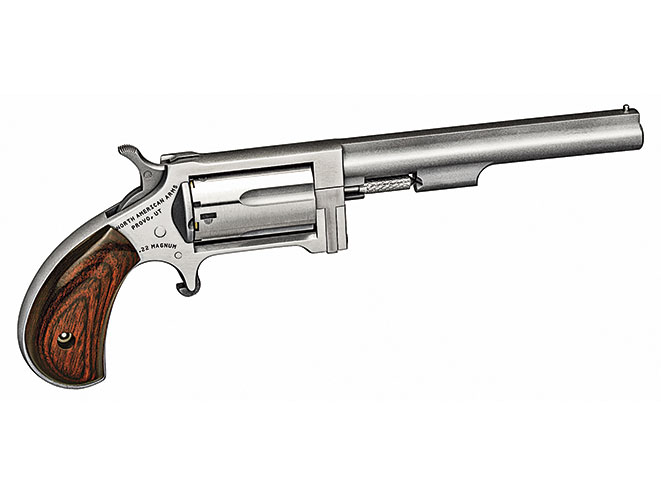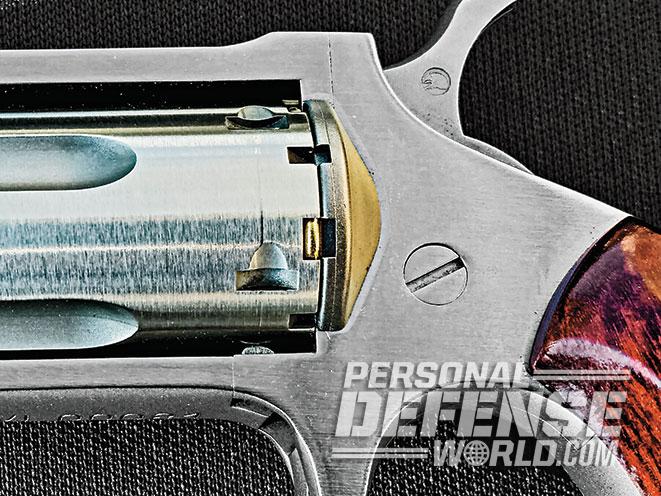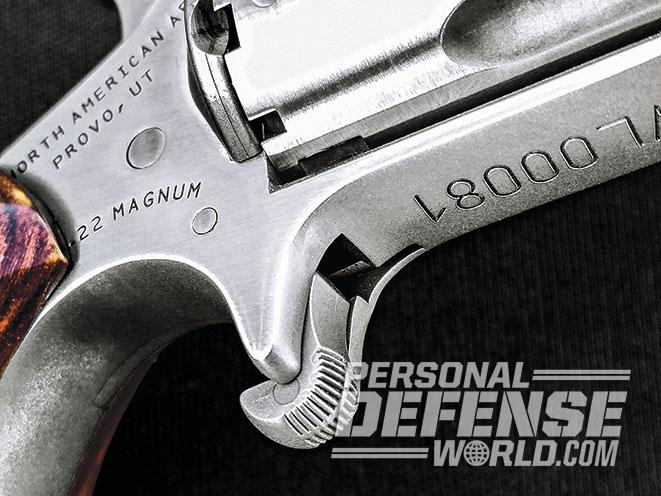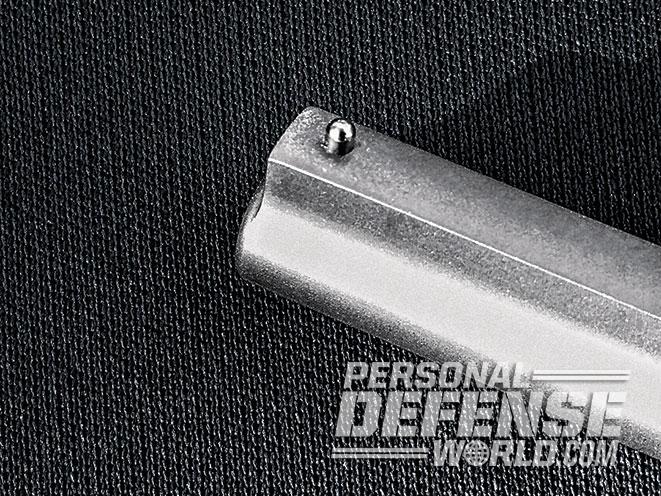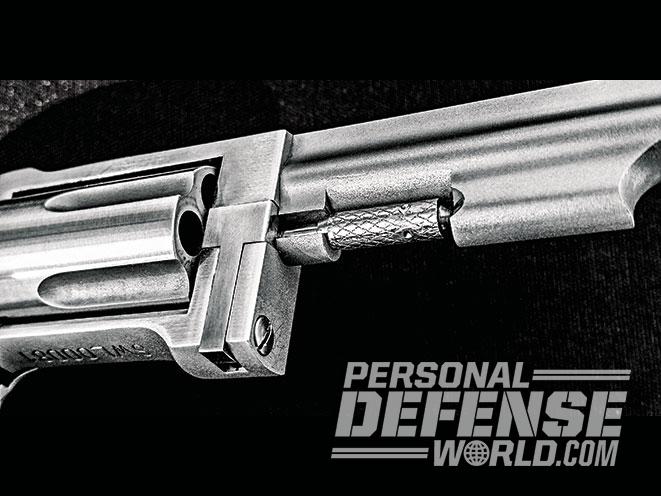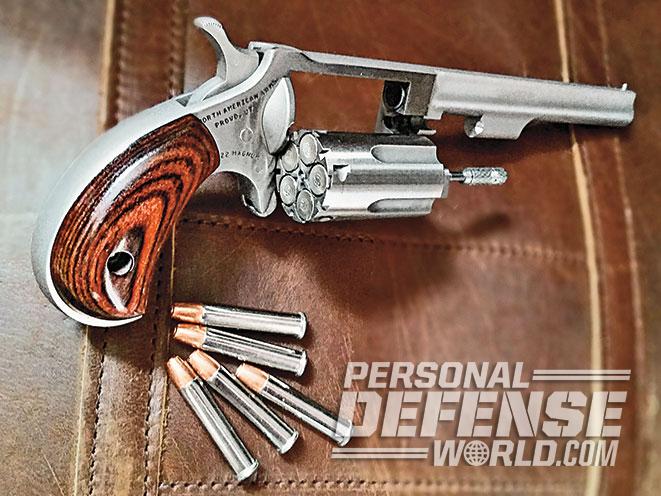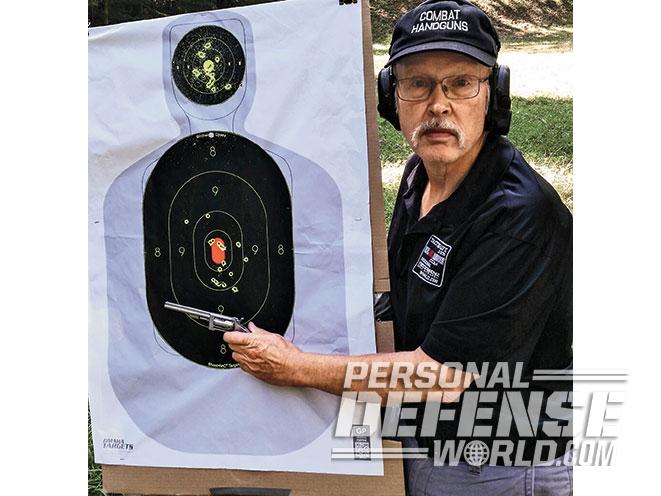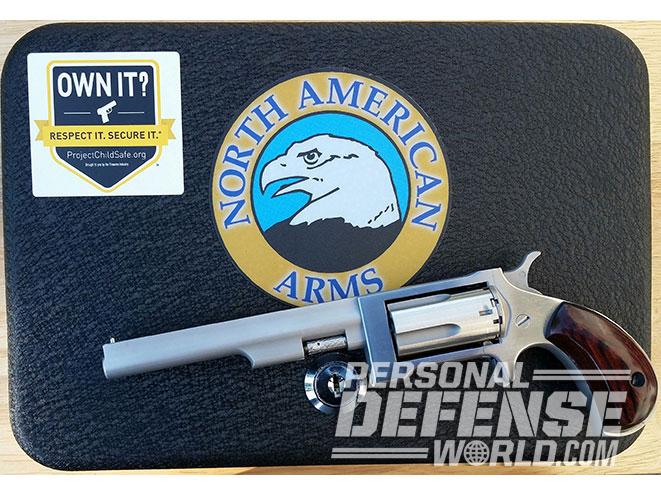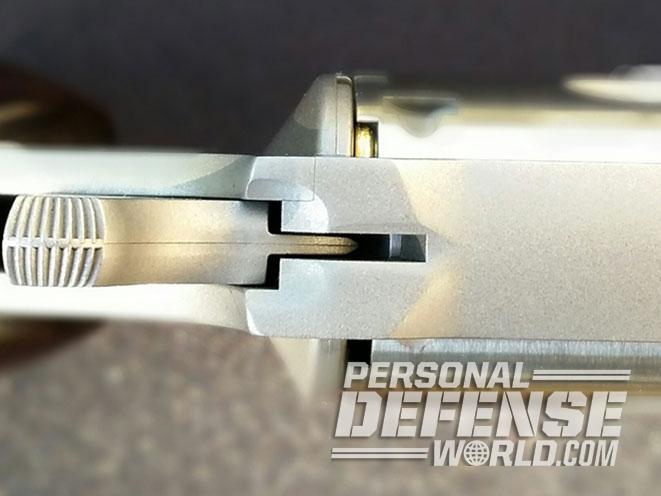A while back, I did a test and evaluation on the North American Arms (NAA) Sidewinder Mini-Revolver Conversion Model in .22 Magnum/.22 LR. If you are unfamiliar with NAA, its largest line comprises several versions of a diminutive single-action, five-shot revolver in .22 Short, .22 LR and .22 Magnum, which the company has been producing in various forms since the early 1970s.
Except for a short-lived hinged-frame model, all the NAA revolvers have had a solid frame that requires the cylinder to be removed for loading or extracting spent cartridge cases. The Sidewinder changed that rule of thumb, as it has an ejector rod/cylinder locking pin that, when pulled forward slightly, allows the cylinder to be swung to the right on a crane, once the hammer has been cocked to the first notch or “click.” This makes for rapid loading and ejection of brass almost on par with typical swing-out-cylinder double-action revolvers.
NAA recently announced the production of a California-legal Sidewinder that sports a 4-inch barrel. Living in America’s heartland, I couldn’t care less about the useless gun laws in California, but I did think that a 4-inch barrel on the Sidewinder could provide some interesting possibilities.
Advertisement — Continue Reading Below
Pocket Upgrade

My test gun arrived in a black “crinkle-finished,” lockable metal box, and inside I found a conversion cylinder for .22 LR. Also inside, beneath the foam-rubber padding, were keys for the case lock, an owner’s manual, a warranty registration card and some other NAA literature. I took the Sidewinder out and gave it the once-over from stem to stern. The gun’s fit and finish seemed up to NAA’s usual high standards and there were no machine marks or other blemishes to mar the little handgun’s good looks.
RELATED STORY: Gun Review – NAA Sidewinder with LaserLyte Mighty Mouse Laser
Advertisement — Continue Reading Below
The Sidewinder is a stainless steel handgun. The sides of the frame and the cylinder are given a brushed satin finish, while the cylinder flutes, barrel, hammer, trigger and the top and bottom surfaces of the frame and gripstraps are matte finished. As this is a single-action revolver, the hammer has a long enough spur to make cocking easy, and the spur is serrated for better thumb purchase. Like many of the small revolvers and derringers seen in the Old West, it has a “spur” trigger that has some protection provided by downward projections of the frame, but no triggerguard. The trigger’s front surface is serrated.

The Sidewinder’s sights are fixed and consist of a small bead at the barrel muzzle, sitting atop an integral rib. The rear sight is a notch cut into the topstrap that can only be seen to aim with when the gun is at full-cock. There’s also a slot cut into the notch that allows one to see the top of the cylinder, which enables the user to place the firing pin in a cylinder safety notch. These notches are on the breech end of the cylinder, along with small cuts that allow a view of the cartridge rims, to act as a loaded-chamber indicator. The Sidewinder’s stocks appear to be laminated rosewood with a soft luster finish and no checkering.
RELATED STORY: North American Arms’ .380 Guardian Pistol with Crimson Trace Lasergrips
Advertisement — Continue Reading Below
As stated earlier, regular NAA mini revolvers require the cylinder to be removed for loading. However, the Sidewinder is a swing-out cylinder design like many modern DA revolvers. To unlock the cylinder so that it may swing on its crane to the right of the receiver, one must first cock the hammer to the first “click.” This takes the hammer-mounted firing pin out of the safety notch and lowers the locking bolt slightly. One hand is used to pull forward on the ejector rod/locking pin while the other hand manipulates the cylinder out to the right.

Once fully pushed out, the ejector rod can now be used to punch out empty cartridge cases. With fresh cartridges in the cylinder, it can now be swung back into the frame window and locked into place. I found this was best accomplished by using one hand to press inward on the cylinder crane and the checkered knob on the ejector rod/locking pin. The barrel has a lug ahead of the pin for protection, and an integral “collar” where it attaches to the frame, which is part of the locking system, also provides some additional protection for the hand.
RELATED STORY: 16 Concealed Carry Derringers & Mini-Revolvers
Advertisement — Continue Reading Below
To convert the Sidewinder from .22 Magnum to .22 LR, and vice-versa, a screw on the front of the frame, at the bottom forward of the trigger, must be turned out and removed with the cylinder in battery. Using the process already described, the cylinder is swung out, allowing it and the crane unit to be lifted free. The user can now insert the conversion cylinder and secure it in place with the frame screw. The laminated wood grips are also fastened to the grip frame with a screw, and NAA has a number of different grip options should you wish to change them out. NAA makes some imitation stag grips I like, as they provide a better gripping surface.

Some might question describing the NAA Sidewinder with a 4-inch barrel as a pocket pistol. Back in the Old West, it would have easily fit into a frock coat pocket, but today’s fashions are a bit different. I found the little five-shooter would tuck into the flap pocket of my cargo pants, but if I was taking it along with me somewhere that had a more formal dress code, I might want to opt for a holster. NAA makes some suitable leather for the 4-inch Sidewinder, and if you like a belt holster, the company makes a Model 1860 in black and tan with basket-weave stamping and a leather thong to loop over the hammer spur for security. It comes in right- and left-handed versions. Another model is the Mini-Master 4-inch, and this is constructed of suede leather and rides inside the waistband. It has a brushed finish, an open muzzle to allow for air circulation and comes in left- or right-handed versions.
Getting The Lead Out
Advertisement — Continue Reading Below
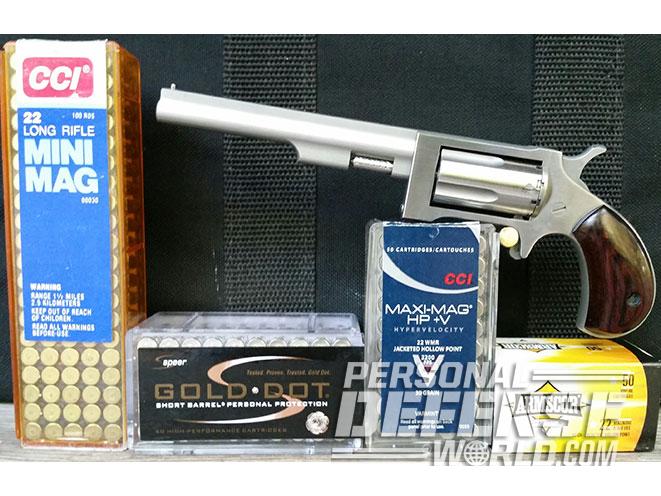
Winchester developed the .22 WMR cartridge in 1959, and for many years it was only offered by the company and some other major ammo producers with 40-grain hollow-point and FMJ bullets at about 2,000 fps (out of a rifle barrel). Today, there are a plethora of .22 Magnum loadings (when you can find them). Some of them are intended for use in short-barreled handguns like the NAA revolvers.
For this test, I selected .22 WMR cartridges from Armscor (Warning: No longer recommended for use in NAA guns), CCI, Hornady and Speer. The Armscor load has a 40-grain JHP with an exposed lead tip. The CCI round is that company’s Maxi-Mag +V and has a “hypervelocity” 30-grain JHP. The final load tested was the Speer Gold Dot. This .22 Mag load is formulated especially for short-barreled handguns and has a 40-grain Gold Dot hollow-point bullet with a factory-rated velocity (out of a 1.9-inch barrel) of 1,050 fps at the muzzle. I wanted try the .22 LR conversion cylinder, so I also selected a vintage box of CCI Mini-Mag 40-grain, solid-point bullets. I was anxious to see what kind of velocities my chronograph would give me shooting the above loads out of the Sidewinder’s 4-inch barrel.
Advertisement — Continue Reading Below
RELATED STORY: 5 Mini Revolvers & Pocket Pistols From North American Arms
From the bench, I put five shots of each load through the tripod-mounted Sky Screens. Next I put my sandbag on the bench and stapled up some bullseye targets downrange at a distance of 7 yards. Even with a 4-inch barrel, I didn’t think the NAA Sidewinder would allow accurate shooting at a longer distance; I may have been wrong.
Even though the sights are right out of the 19th century and the trigger pull was heavier than my pull scale would measure, I was still able to shoot a five-shot group from the bench that came to just 0.93 inches using Armscor .22 WMR ammo. Second place went to the Speer load with a five-shot cluster my dial calipers measured at 1.27 inches. The CCI Mini-Mags in the conversion .22 LR cylinder provided a best group of 1.38 inches for five shots.
Advertisement — Continue Reading Below
Real-World Ready

Since it provided good groups and was the easiest in the extraction of empty cartridge cases, I elected to use the Speer Gold Dot .22 WMR round for the combat test phase of my evaluation. My plan was to first load the Sidewinder and put it in my right cargo-pants pocket. I would then walk up to within 3 feet of the silhouette target and empty five rounds into the head of the target as rapidly as possible using only the strong hand, looking over the sights.
For the next 25 rounds, I loaded the gun, took a giant step backwards and then drew from the pocket and fired three rounds center mass and two to the head. The center-mass shots were just pointed and I took a quick aim at the head. I repeated this giant step process until I was back at the barricade. I then drew the loaded gun, took aim and fired two rounds in left-side center-mass and right-side barricade, then knelt and fired one round to the head from the right side. The results were quite satisfactory.
Advertisement — Continue Reading Below
RELATED STORY: 4 .22 WMR Mini Revolvers From North American Arms
The close-range headshots would have been deadly and the target was peppered with gun-powder stippling. My center-mass shots were centered, with only two hits outside the 10-ring. Be sure to put your hand in your pocket and your thumb on the hammer spur to prevent the spur catching in the pocket lining while drawing.
The overall performance of the NAA Sidewinder with the 4-inch barrel was very favorable. I believe this little five-gun has the makings of a good last-ditch defense gun or backup gun. The 4-inch barrel certainly increases the velocity of the .22 WMR loads considerably, putting it in the same league as many .32 ACP JHP loads with 132 foot-pounds of muzzle energy. It is accurate enough to get good close-range headshots when firing with two hands; cocking the hammer with your support hand, you can get off five shots quickly. Loading and extracting empties is faster than with other versions of the NAA single-action revolver, but you’re still mostly going to have to count on those five rounds in the cylinder.
I’m also thinking it might be a great little trail gun, and with some .22 WMR shot cartridges it would make good medicine for threatening vipers. A big walnut tree was near the range, and with .22 LR cartridges I had no trouble shooting walnuts off limbs, so hitting squirrels would not be an improbable feat.
For more information, call 800-821-5783 or visit http://www.northamericanarms.com.
